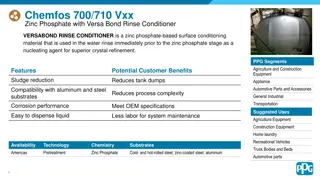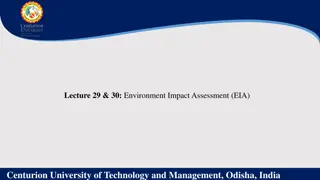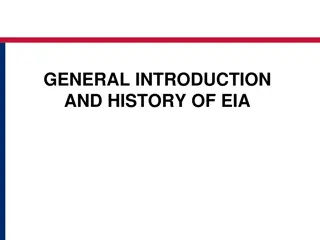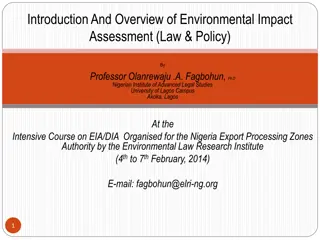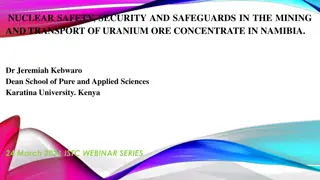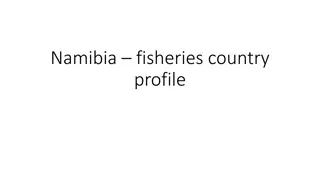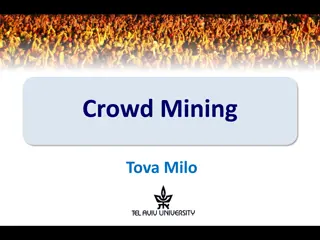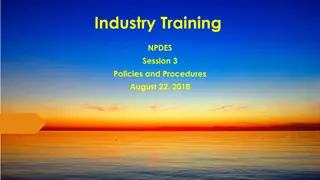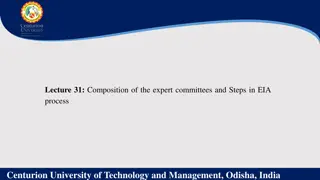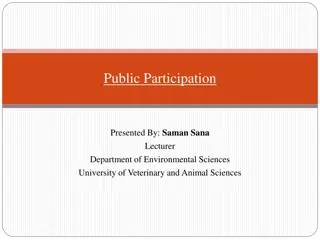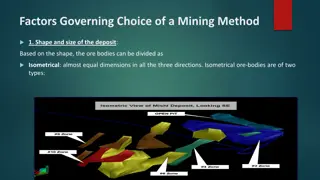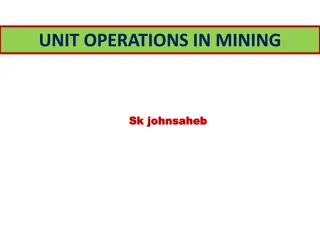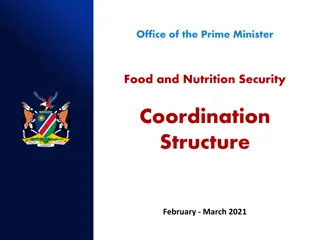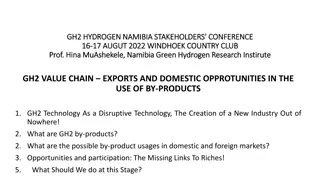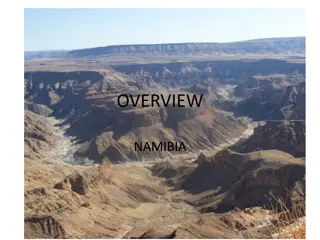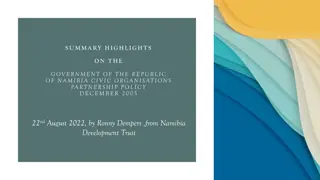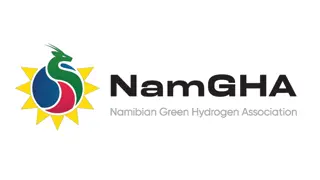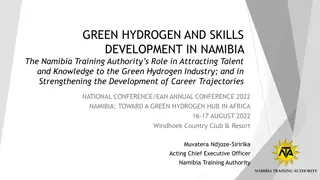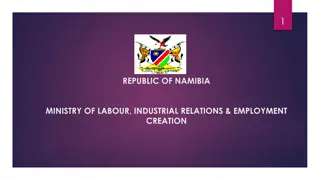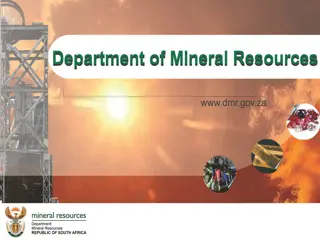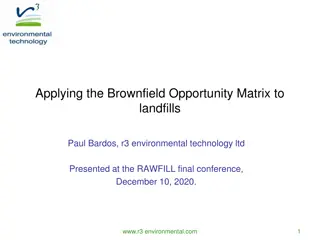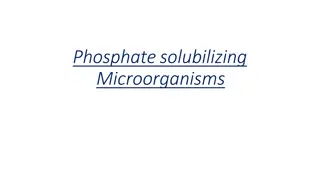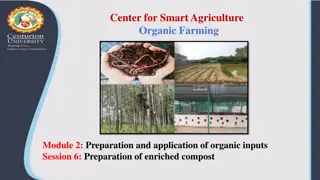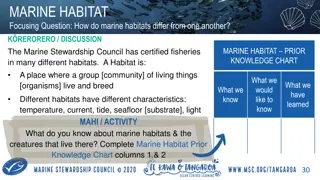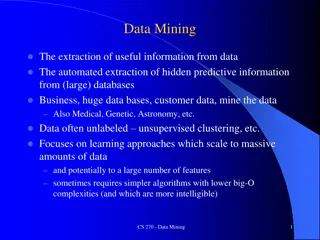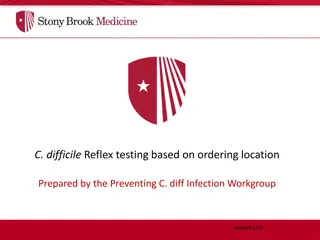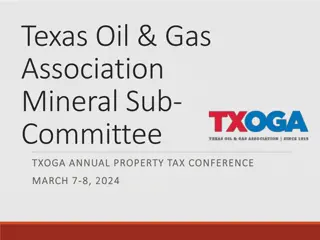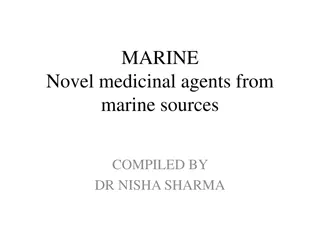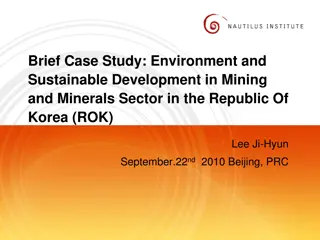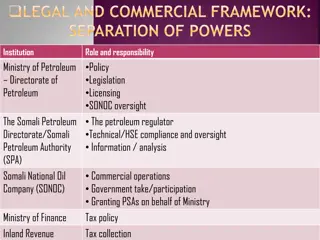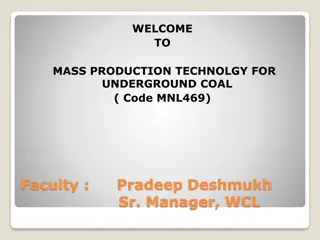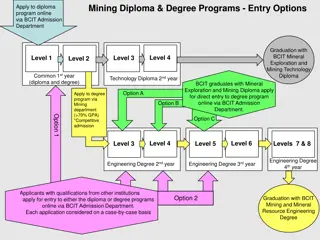Understanding Marine Phosphate Mining in Namibia: EIA Process, Findings, and Decision-Making
Explore the complexities surrounding marine phosphate mining in Namibia, focusing on the Environmental Impact Assessment (EIA) process, key findings, and the challenges in reaching a sound decision. Delve into the global overview of seabed mining, the significance of EIA, and the broader recommendations for improving EIA practices in Namibia and beyond.
Download Presentation

Please find below an Image/Link to download the presentation.
The content on the website is provided AS IS for your information and personal use only. It may not be sold, licensed, or shared on other websites without obtaining consent from the author. Download presentation by click this link. If you encounter any issues during the download, it is possible that the publisher has removed the file from their server.
E N D
Presentation Transcript
Namibia Marine Phosphates The EIA process, findings and reaching a sensible decision Chris Brown (NCE) John Pallett (NEWS) Peter Tarr (SAIEA)
Marine phosphate mining Why this event? Considerable public interest Potentially important new industry, but risks Lots of opinions, distortion of facts, jurisdictional conflicts Polarised viewpoints personal biases Difficult decision (legitimate concerns) Ideas for strengthening systemic weaknesses in managing Namibia s EIA process.
Marine phosphate mining Global overview of seabed mining What is EIA? Understanding and managing impacts Namibia Marine Phosphate process so far What did the EIA say? Critique of the NMP process What does the Environmental Clearance say? What could be a sensible decision? Broader recommendations for EIA in Namibia Discussion
Global overview Currently 25 exploration contracts approved by ISA (UNCLOS) : 4 for cobalt-rich crusts in the South Atlantic and Mid-Pacific 16 for manganese nodules in the Pacific and Indian Ocean; 5 for SMS (sulphides) in Indian Ocean and Mid-Atlantic Ridge. Commercial interest in deep-seabed minerals within national jurisdictions, including in the Pacific Islands region, Mexico, Namibia, New Zealand, Saudi Arabia, South Africa, and Sudan. Deep-seabed mineral exploration licenses issued for SMS by Fiji (1) Papua New Guinea (2) Solomon Islands (3) and Tonga (4). Marine diamond mining in Namibia and RSA for decades.
Big new project good or bad? What are the benefits, and to whom? What are the costs, and who pays? Ecosystem, ecosystem services, biodiversity Society, including local communities Economic sectors and national economy The best, most internationally recognised and constantly improving tool we have to help assess a project is EIA
What is EIA? A process of identifying, predicting and evaluating the biophysical, social and other relevant effects on the environment of activities prior to their authorisation with a view to avoiding orminimising negative impacts and enhancing the positive.
EIA is NOT A decision making tool it is decision aiding The only information used by decision makers An exact science many limitations A confidential process Legally-binding The last word.
EIA process Development concept Screening Feedback Authority review and approval Initial Terms of Reference prepared Proponent/Authorities/Consultants Scoping study Revised ToR for EIA and specialist studies. EIA commences Public input EIA and EMP report
Assessing and mitigating impacts
The challenge is determining: Spatial extent of impacts (local, national, regional, global) Duration (short, medium, long term) Significance (how serious?) Probability of the impact happening Cumulative impacts Avoidance, mitigation, recoverability.
Bottom line: who wins, who loses? The win:win solution is the one where the impacts on the environment are the least, the benefits to society are greatest and the technical costs are lowest Is this possible?
Mitigation hierarchy Option Criteria Common, preferable Preferred option will result in significant impacts requires major re-design Alternative sites or technology to eliminate Impacts Avoidance Actions during design, construction, operation to minimize or eliminate impacts Preferred option is acceptable but there is considerable scope for better within- project alternatives Minimization or remedy No viable alternatives to the preferred option, but impact avoidance or minimization is impossible. Used as a last resort to offset impacts Compensation or offsets Rare, undesirable
Date Action Comments Prefeasibility study Done before EIA scoping Nov 10 Register EIA with MET Dec 10 ML170 granted by MME ML granted before any public consultation, conditional on EIA July 11 Public consultation (scoping) Some meetings held WHK, Swakop, WB + focus groups Sept 11 Bulk sampling completed Unfortunately no monitoring done missed opportunity Oct 11 Public had 11 working days to review. In line with Namibian legislation but inadequate given the fact that the project is a first of its kind in the world. Nov 11 Draft scoping report (marine) submitted to MET (open for comments) Register EIA for terrestrial component EIAs split and not synchronised Nov 11 4-5 weeks after scoping. Specialists maybe unable to address issues raised by I&APs. Public given 15 working days to comment (legally compliant, but short). EIA process almost complete by the time the EMA and EIA regulations were gazetted. EIA and EMP completed (open for comments) Jan 12 Commencement of EMA, (7/2007), publication of EIA regulations. Jan 12 Final EIA + EMP report to MET Internally reviewed by the CSIR Mar 12 Completion of feasibility study Feasibility and EIA correctly synchronised Mar 12 External review of EIA Commissioned by MET, done by SAIEA. Some aspects of the EIA inadequate, others good. Verification studies recommended Feb 13 Sept 13 Phosphate mining moratorium Time frame 18 months Verification studies completed EIA + studies = comprehensive analysis, but limitations Nov 14 Sept 16 Clearance issued Subsequently withdrawn pending consultations.
What the EIA says There are presently no identified issues of environmental significance to preclude the dredging of phosphate-enriched sediments from the Mining Licence Area No. 170. There are however, management and mitigation measures that are to be implemented by NMP and their sub contractors.
NMP Verification Study findings Known commercially viable phosphate deposits cover 0,5% of Namibia s EEZ NMP intend to dredge = 3 km2 per year (0,0003% of EEZ), 60 km2 over 20- years. Flat, smooth seafloor, homogeneous sediment, no protruding rocks or reefs
NMP Verification Study findings In situ sampling, complemented by laboratory analyses Fisheries and Biodiversity study Hake and monk-fish - No spawning or recruitment in ML170 A very small direct impact on hake and monk relative to their overall abundance in Namibian waters Animals such as sea-squirts, brown sponges, sea pens, shrimps, starfish, whelks and worms live in the mud. No site-specific or threatened species of fauna in the mining area.
NMP Verification Study findings Water column and sediments Heavy metal concentrations in the sediments relatively high: - arsenic, cadmium, chromium, copper, nickel. But, the release of metals into the water is low because they are contained within the phosphorous granules. Trawling for fish has resulted in plumes and the release of these metals into the water column for many decades (Nam fish exported to EU). Trophic transfer of heavy metals uptake by plankton. Will not be passed up the food chain.
NMP Verification Study findings Ecosystem No unique features in ML170 The area of impact is so small relative to the overall extent of the continental shelf and the Benguela ecosystem that significant impacts on the ecosystem are unlikely
NMP Verification Study Conclusion Sea-floor mining at ML170 will not significantly harm Namibia s marine environment or the fishing industry There are no objective scientific reasons why an Environmental Clearance Certificate should not be issued and the project permitted to proceed
Critique of the EIA process Poor public consultation after original EIA in 2011. All correspondence with I&APs stopped. Splitting of the EIA into marine and terrestrial components Suspicious of divide and rule Possibly justified in view of the possible discontinuation of the project if marine operations not allowed. But may compromise the decision on the terrestrial EIA.
The Environmental Clearance Certificate was issued subject to the following conditions: If impacts are found to be greater than expected, and no feasible and acceptable mitigation measures are implemented, then the operation shall be closed and the Environmental Clearance Certificate withdrawn. Bi-annual (twice per year) reports on the implementation of the Management Plan (and the monitoring required therein) must be presented to both the Ministry of Environment and Tourism (MET) and to the Ministry of Fisheries and Marine Resources (MFMR). Dredged seabed and water column monitoring must be conducted on a regular basis with reports submitted to MET quarterly. Clearance to proceed is valid for a period of three (3) years.
Conditions continued The proponent must fund the establishment of a centre of excellence to monitoring the impact of phosphate mining and to produce generic standards and guidelines for the sector in future. Data from the monitoring must be freely shared with the competent authorities. The best available technology must be used to have least environmental impact. The mining and processing techniques will be reviewed annually against monitoring data, to be done jointly by the proponent and the regulator. Separate environmental clearance must be obtained for the onshore processing plant.
Are the conditions sufficient? The marine phosphate mining Environmental Clearance Certificate should be made conditional on the land-based EIA also getting an ECC and that the two components are seamless. An independent Committee should be established to oversee the monitoring process, to receive results and reports, to evaluate impacts and adaptive management and to advise the Office of the Environmental Commissioner on two vital aspects: (i) To withdraw the ECC should impacts be greater than anticipated and detrimental to the Marine ecosystem, and (i) Should impacts be minimal, as expected by the respective specialists, how should mining be managed to avoid unacceptable cumulative impacts, and what ongoing monitoring should be done?
Strengthening conditions The above Committee should oversee the establishment of an independent monitoring group and the development of a comprehensive monitoring plan. The Committee should oversee the revision of the Environmental Management Plan and its implementation. A public domain website should be established by the Committee on which all monitoring data & reports are posted, as well as proceedings of their meetings.
Broader recommendations for EIA management in Namibia
Why this level of conflict? It s the process, not the contents of the EIA! Public consultations Not enough to hold a few public meetings early in process & place EIA docs on website Must be a process of engagement Decision-making Should not be left to one official (too much responsibility and heat) The Sustainable Development Advisory Council (SDAC - 4 GRN 4 non-GRN members) should give recommendations.
One size does not fit all For large and potentially controversial projects, design the process appropriately The SDAC should work with the Office of the Environmental Commissioned to develop a project road map which includes a process of public engagement Access to information All EIAs and EMPs and public engagement reports should be in public domain easily accessible, on one GRN website (and never taken down) Project s timelines and events should be on the website All decisions should be on the website.
Accountability by EIA practitioners Need for professional body (e.g. EAPAN) under an Act that required professional standards allows for disciplinary action These actions would significantly improve EIA processes in Namibia, particularly for large, difficult projects. Final thought: being pro-environment does not mean being anti-development. Each project must be weighed up (costs & benefits) on its merits. Anti- development without merit is stupid and has no credibility. It undermines the case for when a real stand needs to be taken for the environment.
Thanks you Discussion


